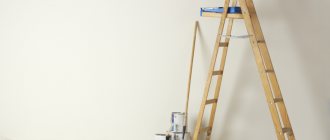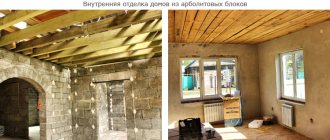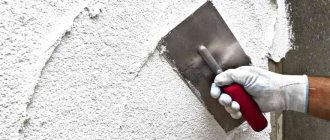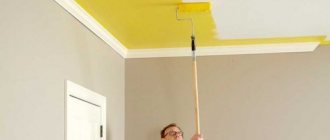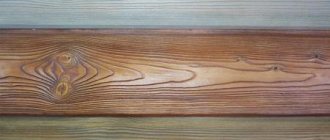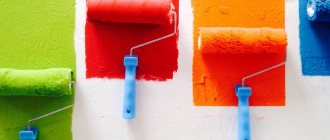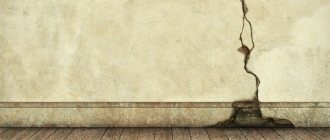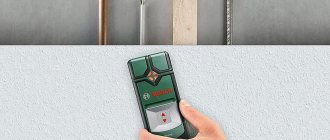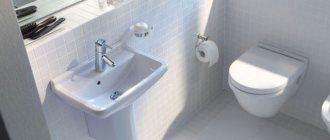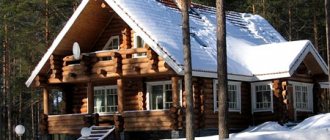05/03/2020Repair0
When it comes to renovating an apartment, many questions immediately arise. The main question is how much will the repair cost? This question has broken the heads of many smart people, and also gutted the wallets of many family budgets. But in reality, if you approach this issue in a modern way, you will not need to use expensive facing materials, and you will need to use inexpensive raw materials to carry out high-quality repairs.
- 1 Possibilities of symbiosis of using decorative plaster with old wallpaper on the walls
- 2 How to combine decorative plaster and wallpaper?
How to combine decorative plaster and wallpaper: 3 tips
Today we will consider the issue of combining wallpaper and decorative plaster
in the interior of a living room, bedroom or hallway. How to choose colors, combine materials, where is the best place to make the transition? Read in the article!
- Avoid outside corners
Don't forget that the weakest point is the outer corners
. This is a place where you should never trim the wallpaper. If you have wallpaper on one wall and decorative plaster on the other, do not join the materials at the corner! After some time, the wallpaper will begin to peel up, come off, and then it will be very difficult to restore it.
The only adequate solution in this case is to use a decorative corner. But you have to be careful: it doesn't always look good.
Therefore, please note: the transition of one material to another, including the junction of wallpaper and decorative plaster, can only be at the internal corners
. This place is safe, no one will catch the inner corner, and such a solution will look quite natural.
To make the junction look as neat as possible, decorative plaster is first applied, and then the wallpaper is glued. And don't try in reverse!
2. Apply protruding elements
These same protruding elements are pasted over on all sides.
:
- some structure protrudes, and wallpaper goes around it from different sides;
- the opposite situation: there is some kind of niche, and inside the niche there is decorative plaster.
3. Choose the right place
Let's say you are thinking about finishing materials for an open living room that smoothly transitions from the hallway. Decorative plaster will be an ideal material for:
- high traffic areas;
- kitchen area;
- door slopes.
Look at the visible corners, decide on the key areas and understand for yourself where on the inner corners you want to connect one and the second material. And don’t forget the most important thing: the transition of one material to the second should not be within an open (outer) corner.
Source
Wallpapering around switches and sockets
If the socket and switch have not yet been installed, then steps 1 and 2 can be skipped:
- De-energize the switch or socket, and then carefully remove it from the socket and disconnect the wire;
- Hide the wire in the socket so that it does not interfere with the pasting, having previously insulated it;
- Paste a piece of wallpaper over the hole for the switch or socket;
- Take a utility knife and make a circular cut along the outline of the hole;
- Carefully smooth out the wallpaper with a plastic spatula next to the hole.
How to properly join different materials
There are no problems only with joining similar materials (wallpaper of different patterns, for example, within an accent wall). But designing the junction of different materials is already a task. It's not just a matter of different thicknesses or mismatched textures. The junction usually lacks logical completeness; the junction does not look very cultural.
How to proceed? - Depends on the place where both materials meet: on the surface (wall or ceiling), in the corner between the walls or between the wall and the ceiling.
Task 1: Joints on the wall or on one surface
Solution 1: Pronounced difference The simplest option to connect different materials is to screw a sheet of plasterboard at the junction of the coverings. The minimum difference is 12 mm: this is enough to separate different materials. But it is possible to build more complex structures - it depends on the task and capabilities. In any case, a joint made by a difference in planes will look logically complete.
Another example of separation using a difference in planes. Control lighting was installed behind the decorative panel. The frame above is an example of what the junction of different materials looks like in natural light. Enlarge to enjoy the beauty of the textures!
Four plane differences were used on one surface
Solution 2. Bring to one level This happens when you have to join a relief material of a certain thickness and a smooth one (like wallpaper or a wall painted on plaster) in one plane.
The same drywall will help - “bring” the failed fragment exactly to the protruding level, as was done, for example, with the transition of a slatted wall into a decorative fragment behind the headboard.
Important: You need to think about joining materials at the design project stage in order to develop drawings for the structure in advance.
Solution 3: Frame There are two ways to frame the joint of coverings using moldings and borders.
- Frame the selected fragment around the perimeter.
- Separate the materials with molding. Typically, this option is used in classic interiors and is done horizontally: the lower part of the wall is finished with one material, and the upper part with another. There is a molding between them. A simplified version of this method is companion wallpaper pasted across the border.
Important: If the materials are joined vertically, then separating them with molding is not the best idea. The molding will “rest” against the ceiling and floor, and the entire composition will remain unfinished. In addition, you will also have to think through the joining of the molding to the baseboard.
An example of artistic framing - typical for a classic interior
Solution 4: Decorate it artistically (casually) Once we decorated a wall with paintings. The painting itself was made on a piece of hardboard and glued to the wall. As a result, we got two different textures: the hardboard with the painting is one texture, the wall around the painting is another. The edge of the hardboard was cut carelessly, with jagged edges, but we planned to frame this entire composition and did not worry about the uneven edge. When everything was mounted on the wall, this uneven edge perfectly “made friends” with the textures and plot of the painting, and overall everything looked harmonious. They didn't make a frame. This is how the artistic joint turned out (you can see a close-up in the photo).
A similar solution with a stone slab - the uneven edge is the basis of the concept; additional emphasis is placed on it using contour lighting
Solution 5. Play with furniture. The transition of materials, if it is consistent with the placement of furniture, need not be formalized in any way. In the horizontal plane, beat it with a shelf (as shown in the interior in the photo). Vertical - with a built-in wardrobe or shelving.
An example of a vertical joining (behind a narrow door there is a built-in wardrobe. The niche was formed at the moment of the “counter” recessing of the wardrobe from the next room. It would be strange to leave just a door on the wall - we continued by covering the wall behind the sofa
Solution 6. Achieve a perfectly symmetrical joint This is rather an exception to the rule, when two materials are laid out in such a way that they look normal (complete) without any visible additional tricks with raising the height or framing the edge.
It seems that this is advice from the series “don’t do anything - the joint will still turn out beautiful.” But in practice, behind such “successes” there are serious miscalculations in the layout of materials. Please note that both examples (here and in the photo above) are built on the verified geometry of horizontal lines in the layout of materials.
Task 2: Joints in the corner If two materials of different textures are joined in the corner, for example, smooth painting and textured plaster, the corner will look sloppy. The plaster ends in the corner and creates a visually uneven line. And even if the angle is drawn perfectly, it will feel like it’s crooked. What can be done in this case?
Solution 1: Move the joint line to the wall To do this, you need to apply paint or a smoother coating to the wall with plaster. A convenient offset width is approximately 2 cm: the thickness of the masking tape (19 mm). Yes, the uneven edge will not go away due to the texture of the plaster, but it will no longer be in the corner, but on the plane of the wall. This junction of materials looks more aesthetically pleasing and is not noticeable.
How to combine decorative plaster and wallpaper
The question of what impression the interior of your “home” will make on guests is probably always relevant. People are greeted, as they say, by their clothes, and in the case of your place of residence, the role of such clothes is the hallway - the room by which the house as a whole is often judged. Don’t give your guests a reason to think badly about it - decorative plaster in the hallway, a photo of which we offer today, will help form an extremely positive impression.
The choice of decorative plaster as a facing material for your hallway is not surprising due to certain advantages that it has:
- hides architectural unevenness of walls
- extremely easy to care for
- environmentally friendly and safe for humans
- insulates the room
- Possibility of post-painting and adaptation to any type of interior
The existing variety of solutions in this area allows you to choose the type of texture that is optimal for you and give the interior of your room the necessary ambience. What happens?
- Smooth
- Textured
- Venetian
- Bark beetle
- Other options
Liquid wallpaper: how it differs from plastering
To complete the picture, it remains to analyze the main advantages and disadvantages of liquid wallpaper. Despite its name, this material has some features of plaster and is similar in the method of application. Even its second name, silk plaster, speaks about this. The composition includes cellulose, cotton, and sometimes silk fibers, adhesive binders, plasticizers and decorative glitter.
Advantages of liquid wallpaper
- The damaged area of the coating can be easily repaired if there is unused mixture left at home. In the right place, the old wallpaper is scraped off and new wallpaper is applied.
- They are laid not only on vertical, but also on horizontal surfaces.
- The resulting coating has no joints; cracks and voids in the wall are filled with finishing mortar. Therefore, the wall does not need to be puttied and leveled beforehand.
- This finish effectively absorbs sound and has additional thermal insulation properties, albeit not great ones.
- It’s easy and comfortable to work with; they don’t leave a lot of debris behind, like plaster.
- They often contain fungicides. They prevent the development of mold.
- The cost is usually cheaper than decorative plaster, taking into account the necessary previous work.
Disadvantages of liquid wallpaper
- They are afraid of water. This limits their use and makes wet cleaning impossible.
- Low wear resistance, finish is easy to damage.
The choice of one or another finishing material is a matter of taste. Some parameters may become more significant, depending on the preferences of homeowners, others less so. Decorative plaster is good when the property is owned, a professional designer or architect has developed an interior solution, and there are no plans to change it for a very long time.
Wallpapers are more suitable for mobile and impulsive individuals. Although here, as always, to resolve the issue it is important to consider a specific case.
Smooth decorative plaster
Its surface is often very difficult to distinguish from wallpaper due to its smooth texture. Take a look at the photo of the hallway in the interior and try to spot the differences by eye. It is unlikely that you will be able to do this.
Smooth plaster option for the hallway. The door slopes are lined with decorative stone and blend perfectly with this material.
Here is another photo of this room. It shows much better all the advantages of the chosen solution.
A light beige version with a texture that is barely noticeable to the eye. It cannot be said that this particular plaster has a pronounced decorative character, but there is no doubt about the practicality of its use.
How to hide the resulting overlap of the edges of wallpaper with your own hands
As long as the glue and wallpaper are of good quality, there are usually no problems with the resulting joint. In this case, it is necessary to promptly remove excess glue from under the joint, so that later it will be easier to hide the seam between the panels. The glue must not be allowed to dry out at such a joint. Traces from the glue and from the glued edge of the adjacent panel that overlaps on top will be very difficult to hide; you will have to do a thorough and lengthy cleaning of the wallpaper from the remnants of the adhesive mass.
The procedure for eliminating the overlap is carried out after about 10 hours, when the material has thoroughly dried and has already acquired the necessary rigidity, and the glue has not yet completely dried. Along the resulting joint, using a plumb line and a long metal ruler, preferably a meter long, you need to make a thin vertical joint line.
We apply a steel ruler according to the markings, and simply cut the seam with a construction knife with a thin blade. The resulting barely noticeable light cut will be tinted with the appropriate dye after the wallpaper has completely dried.
Varieties with the effect of decorative plaster
Wallpaper with imitation plaster is always two-layer. They are distinguished by the type of base and external side. When choosing finishes for rooms of varying functionality, decorativeness sometimes fades into the background; we are talking about performance characteristics.
Wallpaper with imitation plaster is always two-layer.
Duplex
This is the name for canvases with paper embossing. Depending on the component composition of the outer layer, products of different expressiveness are obtained. Simple, paper ones are not durable, they have to be changed every 5 years. In the manufacture of duplexes, polymer impregnations are used. Wallpaper with silk plaster has a long service life, silk-screen printing has a smooth structure. This is a moisture-resistant finishing material. The embossed duplex allows air to pass through, the walls “breathe”. It is easy to apply a multi-color design on paper. White paintable options can be repainted up to 5 times.
Wallpaper with silk plaster has a long service life, silk-screen printing has a smooth structure.
Vinyl wallpapers
Among vinyl canvases, white wallpaper under plaster is considered the most practical. There are two types of base for vinyl: paper and non-woven. The strength of the sheets depends on the structure of the substrate. Some people are not afraid of brushing. The top layer of polyvinyl chloride can be hot-stamped; during production, the wallpaper is passed through embossed rollers. There are models that simulate spraying. In this case, the polymer is airy and light.
Disadvantages include low air tightness. Some types of vinyl wallpaper are not resistant to mechanical stress.
When gluing vinyl on a paper or non-woven backing, it is worth purchasing an anti-fungal primer. Fungus will develop under the loose polymer layer after leaks from above.
Among vinyl canvases, white wallpaper under plaster is considered the most practical.
Non-woven wallpaper
Wallpaper that imitates a layer of plaster is often made on a non-woven backing. This material, made from plant fibers or cellulose, is much stronger than paper. It can be used to create a textured layer up to 5 mm high. Non-woven fabric is as safe as paper and adheres well to many types of building materials.
Luxurious wallpaper is made on non-woven fabric, imitating finishes with gilding, mother-of-pearl, and quartz sand.
Wallpaper that imitates a layer of plaster is often made on a non-woven backing.
Textured
In contrast to a smooth texture that does not have much variety, textured decorative plaster proudly takes on noble rocks.
The use of such texture undoubtedly gives the living space a certain stately aplomb.
Decorative plaster in the hallway looks especially advantageous. Tenderness, warmth, comfort - what other words come to your mind when you look at such an interior in front of you?
Not an example, but a real revelation in the context of modern design art. The texture most closely resembles the skin of a crocodile that went to the next world a couple of hours ago. This option is most suitable for apartments and houses furnished in the Art Nouveau style.
Pleasant to the eye decorative plaster with a vertical texture that significantly expands the narrow space of the hallway. The wood texture significantly enriches the room.
The natural rocky structure in any of its manifestations - in tiles, plaster or any other type of material - always attracts attention with its impressive execution.
Another option for plaster in the hallway. A somewhat harsh imitation of stone blocks favorably mirrors glossy stretch ceilings, creating an impressive design composition. The owners of this room are definitely not afraid to experiment with texture and strive to move away from popular color schemes. Which in itself is not bad and at least arouses interest and respect!
The renovation is not yet complete, but its results are already clearly visible.
A striking example of how well ordinary structural plaster can be combined with other materials, for example, with decorative stone or plaster.
Understanding the design in the hallway - gallery of 15 more solutions
The hallway is the face of the apartment and the house. She sets the mood for every guest. We think that in the interior of the corridor, interior decoration with decorative plaster, as in the photo in the hallway below, will be useful for future use. Advantages over other coatings:
- High mechanical resistance to damage;
- Possibility of wet cleaning;
- The ability to expand space and enhance lighting levels.
We recommend using Venetian marble, mother-of-pearl or pearl finishes, “bark beetle” with a pattern that enlarges the room, or unobtrusive relief plaster. From the color scheme, choose light colors, but based on convenience - for particularly “dirty” rooms, it is preferable to make the apron from below dark.
In the aisle Two colors are combined In the hallway Beige Flat To match the cabinet With lighting Gray in the apartment Combinations of white In the corridor In two layers Plaster in the hallway Primary Thin layer
Painting the walls
Wall covering plays an important role in the further design of the room. The choice of colors depends entirely on the owners of the room and their taste preferences.
Neutral light gray wall color
A living room in gray or matte shades looks comfortable and will promote relaxation. Ivory (or pure white) will give the room freshness and cleanliness, and fresh floral arrangements will add a summer theme to the interior. Gentle blue shades will fill the interior with a pleasant tint that pleases the eye. Bright wall decoration is suitable with a minimum amount of furniture.
Important. To avoid evaporation and moisture accumulation, it is recommended to paint the walls in the living room with oil or enamel paint.
Painting the living room wall in 2 colors
In modern design, it is possible to use combinations of different styles, in which one wall is painted brightly, and the second is pure white or beige. This combination should be combined with interior items. This color will help expand the indoor area and add light.
Matte paint does not create glare
To create a homely feel, you can use pale orange or yellow colors, and you can also choose a carpet or lamps with a hint of yellow. To brighten up the interior, you can use wallpaper with discreet patterns in the form of hieroglyphs or flowers.
↑ back to contents
Venetian
All the features of rocks are brilliantly conveyed by “Venetian” - perhaps the most popular plaster in recent times. It is universal and quite varied, so you definitely won’t get bored after making this choice.
Not convinced? Maybe it will turn out like this: one of the most beautiful projects with the “participation” of decorative plaster, distinguished by the balance of the depicted details and an extraordinary atmosphere. Well-placed light creates a beautiful illusion of gilding on the walls. Most ladies will appreciate it, I suppose.
Not everyone knows, but plaster can be painted any color you like. Apparently, the owners of this hallway are well aware of this and have already managed to choose the right color based on temperature and shade.
What is natural is not ugly. And we will even say more: it’s wonderful. Probably, this amazing naturalness of the dominant pattern is where the special appeal of Venetian plaster lies.
An elegant and aristocratic version of the hallway. The room is bright, cozy and not the least role in this is the plaster applied to the wall.
Necessary tool
First of all, it is important to decide what tool you will need to apply the plaster. Interestingly, in some cases you can use one spatula. However, if we are talking about fast work, then this will not work. This option is only suitable if a specialist has taken up the matter.
Tool
You can't do it without a masterful approach. In order for the work to be successful, it is important to use the following tool:
- especially for mixing work - a large capacity container;
- for direct work – a small container;
- a drill with a mixer attachment;
- for plaster trowels;
- trowel;
- plastic and metal graters;
- different spatula sizes;
- having hard bristles, flat-shaped brushes (one of them is a brush);
- sponge of rigid structure;
- a roller with a pattern to create relief on the walls.
As you work, you may need more tools, but these will suffice to get you started. The main thing is to purchase everything in advance, so as not to be distracted from work later. Find out about brick-like decorative panels for interior wall decoration here.
Designer decoration in the bedroom
Decorative plaster in the bedroom is rich in textures and colors. In our opinion, textures such as silk or velvet are especially appropriate. The “bark beetle” successfully places accents, and light shades using the “concrete” technique are suitable for a bedroom in the Art Nouveau style.
The color is especially important here, which is easier to choose if you understand which side the windows face. If this is the north, then use warm and pastel colors: peach, coffee, beige, pink. If this is the south, then the color is cold and restrained: blue, light green, silver. If it so happens that there are no windows at all, then choose any color, the main thing here is the size of the bedroom: the rule here is that the smaller the room, the lighter the color. Particular comfort is created by details in red and beige shades.
The presented photos of decorative plaster in the bedroom interior will help you choose the right texture and color.
Above a large bed with pillows In a bright room In a beige style In a bright bedroom For newlyweds In a hotel room In a woman’s bedroom In Khrushchev-era Plaster in country style With high ceilings Near the park With LED lighting In grandma’s room For parents
Bark beetle
This type of decorative plaster can rarely be found in the hallway. But it is possible: here is a vivid example of this. The bark beetle is mainly used for finishing facades, but there are also exclusively home options.
For example, this one. A pleasant atmosphere is immediately established in the hallway, conducive to a serene rest.
Solid appearance and increased practicality - a homeowner using a bark beetle is chasing two birds with one stone and successfully catching up with them.
This photo demonstrates the somewhat ascetic design of the hallway. However, the decorative plaster in the photo adds notes of orderliness and universal balance.
Note to all those who have planned renovations in the hallway: bark beetle is recommended to be used in rooms with a large supply of square meters.
Roll wallpaper or decorative plaster?
Wallpaper is the most popular material for wall decoration in the budget segment of interior decoration. However, they can also be quite expensive. The cost is significantly influenced by manufacturing technology, the attractiveness and complexity of the picture, and the country of origin.
Pros of wallpaper
- Wallpapering is considered a simpler operation than working with decorative plaster. This is reflected in the prices of construction companies; the labor of finishers in this case will cost less.
- Because of the simplicity of this finishing, anyone can do it. Wallpaper can be hung quite well on your own without the involvement of specialists; obtaining high-quality decorative plaster by an inexperienced person can be a difficult task.
- This is a rolled material, knowing its width and length, as well as the area of the walls, it is easy to calculate how many pieces you need to purchase.
- High-quality wallpaper from well-known brands is stored for a very long time without loss of useful performance characteristics. Unused material can always be used to repair the coating or decorate another room.
- The appearance of the walls can be changed every 2-3 years without a heavy burden on the family budget.
Flaws
- Standard paper wallpaper is very flimsy and often breaks when applied in the hands of non-professionals.
- Textiles absorb dust and therefore need to be vacuumed periodically.
- Washable ones do not stick well to walls; they need a completely dry surface.
- They are not suitable for finishing rooms with high humidity.
- If the gluing technology is violated, there is a risk of fungus appearing under the wallpaper.
Textured plaster has always been a fairly popular finishing option. There are solutions of different properties and appearance; if desired, you can plaster any wall. The coating will fit normally in the bathroom, on the facade, in the living room, etc. Regarding appearance, decorative plasters have no fewer ready-made colors, but with their help you cannot get a colorful pattern like, for example, photo wallpaper.
Benefits of plaster
- Decorative plaster imitates different materials: marble, masonry, wood, fabric, leather, etc.
- In the process of applying it, a unique pattern is created. Self-tinting allows you to get any desired shade.
- There are no seams on the wall.
- The material is durable, heat and moisture resistant, and resistant to ultraviolet radiation. It can be used outdoors, in the bathroom, swimming pool, kitchen.
- This type of coating plays the role of additional heat and sound insulation.
- Plastering of the ceiling is possible.
- Serves approximately 10-15 years.
- Washing does not harm the coating.
Flaws
- To get high-quality decorative plaster, you will have to hire a professional or spend time mastering the application technique.
- Apply only to a flat, prepared surface.
- Removing dirt from pores is problematic.
The listed pros and cons do not apply to all types of decorative plaster, but are given as general characteristics.
What do you like best?
It is impossible to clearly determine which finishing is cheaper; it all depends on the specific material; in the finishing segment, the cost for a product with similar properties sometimes differs several times, depending on the manufacturer and the beauty of the decor. Only one thing can be definitely stated: for the work itself, the finishers will take more money when plastering.
Application options
There is room for fantasy to run wild: walls, ceilings, slopes. Niches and protruding structures are decorated with plaster. An original solution for the living room would be a panel made of decorative plaster. Three-dimensional, full wall. And, conversely, a small painting the size of a TV or bathroom mirror.
Walls
Any idea can be implemented on the walls. Decorative plaster is complementary to all styles. A classic living room with stucco and Venetian marble for formal receptions, a fresco with floral patterns above the fireplace in a country house, a simple “fur coat” in the hall where the family gathers to drink tea in the evening.
Surfaces are covered entirely or in sections separated by moldings of any size and configuration. An accent wall can do all the work of attracting attention and become a work of art.
Using polymers, dyes and special techniques, craftsmen imitate other types of cladding. Not just rock or wood, even fabric and leather.
Ceiling
What is important here is the ability of plaster to mask irregularities and cracks and to easily adhere to different materials. There are compositions for drywall, concrete and wood.
It is important that the surface is well prepared and can withstand the weight of the finish. It will be difficult to plaster only a wooden ceiling; this requires expensive preliminary work.
Colors and textures are no less varied than for walls. The ceiling can be white with a fine-grained pattern made with a regular sponge. Or mirror-smooth with complex shade transitions, made using the Venetian technique. For the loft style, designers suggest imitating concrete slabs.
Finishing of stoves and fireplaces
Finishing stoves and fireplaces with decorative plaster is necessary for safety reasons.
Finishing creates additional protection and reduces the likelihood of carbon monoxide entering the room through seams and cracks in the masonry. For these purposes, the first layer is mixtures based on clay, cement and gypsum. The material must be heat resistant. Plastic enough not to crack when cooled.
The finishing layer of plaster on a fireplace is usually thin. Most often, rough, finely divided crumbs are used. Compositions containing marble, brick dust and even straw are suitable. It is important that all additives do not release toxic substances when heated.
Arch
An ancient architectural element in a modern interior will look most organic with a brick or stone finish.
An imitation of masonry made using a stencil and acrylic putty will be cleaner and more accurate than the real thing. It is easier to make and lighter, which is important for plasterboard structures.
In the industrial style, brick arches cite the shapes of the spacious rooms of old factories and factories, which so inspire designers. The Mediterranean style, which is also characterized by this detail, requires warm colors and natural materials. For example, patterns like natural stone or craquelure on baked clay. Arched openings with malachite trim look very impressive. A skilled craftsman can achieve the effect that the inside of the wall consists of a single piece of expensive rock.
Instructions for applying plaster
Having prepared the necessary tools (rollers, spatulas with different shapes of the working part, metal graters, containers for mixing working compositions), you can proceed directly to the finishing work. Instructions on how to apply decorative plaster with your own hands:
- The walls are thoroughly cleaned of old coating.
- The cracks must be sealed and the protrusions chipped off with a chisel.
- The surface of the walls is treated with various types of primer, the composition of which depends on the type of plaster used (silicone or Venetian).
- The working mass is prepared according to the attached instructions in a separate container. The mass is thoroughly stirred so that the non-coloring pigments are evenly distributed throughout the coating.
- Apply the plaster to the wall surface in small portions, carefully leveling the stylish coating.
The next step is to use a damp trowel to follow the contours of the main design. The final stage of finishing work is carried out after the plaster has completely dried. The surface of the wall is sanded with sandpaper to get rid of defects and irregularities.
Source
